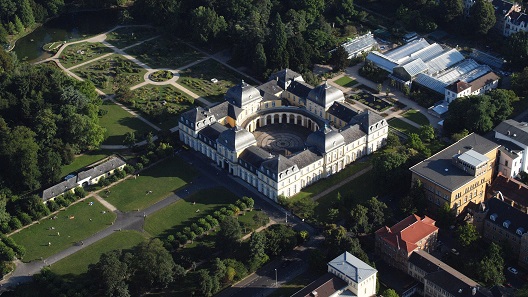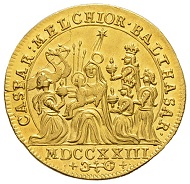by Ruedi Kunzmann
translated by Annika Backe
The year is 1723. On November 12, Archbishop Joseph Clemens Kajetan of Bavaria died in Bonn and was buried in the tomb of the Wittelsbach family in front of the Shrine of the Three Kings inside the Cologne Cathedral. His eventful life deserves a brief portrayal here, for it gives us some hints for answering questions about his gold coins.
Archbishop Joseph Clemens Kajetan of Bavaria.
On December 5, 1671 Joseph Clemens was born in Munich, as the second son of Prince-Elector Ferdinand of Bavaria and Henriette Adelaide of Savoy. Since it was planned that his elder brother Max Emanuel was to become Prince-Elector of Bavaria, Joseph Clemens should have entered the holy orders, regardless of the fact that he himself would have liked a military career much better. A minor still under the influence of his brother, the young man was given a number of functions in short succession, starting in 1685: Bishop of Regensburg, Bishop of Freising, Prince-Provost of Berchtesgaden and, in the same year, Archbishop of Cologne.
The conflict known as the Cologne Diocesan Feud revolved around the issue that the Bavarian line of the Wittelsbach familiy, with Joseph Clemens of Bavaria as their pretender to the succession, stood in competition with William Egon of Fürstenberg as their opponent; it is said that large bribes also changed hands. Though neither side could win a 2/3 majority, the Fürstenberg family considered itself rightfully elected and so William Egon of Fürstenberg had important places in the archdiocese militarily occupied. With papal-imperial help, the Bavarians finally succeeded in having Joseph Clemens becoming Archbishop of Cologne.
Poppelsdorf Palace – Joseph Clemens was inspired by Versailles. Photograph: Wolkenkratzer / Wikipedia.
A few years later, the young archbishop felt insufficiently supported by the emperor and, shortly before the imminent War of the Spanish Succession, turned to King Louis XIV. In the following months, with the conflict situation increasingly sharpening, large parts of the archdiocese were occupied by troops that were loyal to the emperor, to the result that, in 1702, Joseph Clemens was forced to go into exile to France for a few years. It was only after the 1714 Treaty of Baden and Rastatt that Joseph Clemens of Bavaria returned to his diocese which had been administered by the diocesan chapter in the meantime. He was to stay there, until his death in 1723, as the pomp-loving Baroque sovereign and archbishop.
All these events also had an indirect influence on the coins from the Archdiocese of Cologne; both on the period of minting with interruptions and the elections of the mint master(s), mainly for financial reasons.
Let us have a look at the numismatics of the Archdiocese of Cologne, then. (Based on his own collection,) renowned collector Albert Noss (1855-1947) remarked in his important work on the coins and medals form the city of Cologne that a certain Friedrich Wendels served as mint master for many years, active even after the reign of Joseph Clemens. Under Wendels, not only silver coins were minted but noteworthy gold strikings as well of which the ducats and multiples are of particular interest to us. Wendels was not always without controversy, so that, in 1721, Joseph Clemens also hired two French-Walloon coin technicians as mint masters, hoping that this would lead to his minting business yielding more profit, which he could spend on his sumptuous life at the court and the enormous state expenses. Real life, however, looked different, and so the former mint master was employed again.
Back to the episcopal gold coins. Exceptional in terms of their motif are those specimens that feature the adoration of the infant Jesus by the three magi Caspar, Melchior, and Balthasar, which also are, as is commonly known, the patron saints of the city of Cologne. Minted in 1698 (though bearing the date 1696), thus even before the archbishop went into the French exile, very rare triple ducats with this motif (Noss 592 and 593), in two reverse variants have come down to us. Of course these coins are purely representational pieces, though several years later, there were also ducats featuring this motif, which were probably produced for actual circulation.
After the exile had put the coining on hold, Archbishop Joseph Clemens started minting ducats (Noss 628) again in 1715. They show the bishop’s portrait and, on the reverse, the entire, divided chapter’s coat of arms. It is only natural that it does not exhibit special motifs, for these “ordinary looking” ducats were produced for the trade. After a second seven-year interruption, another such ducat was made in 1722, similar to the one dating from 1715 (Noss 671).
If the ageing sovereign was lacking representational gold coins or if ducats were in fact needed, we cannot say for sure. Bearing the Roman date 1723, the following ducat actually adopts the three-magi-motif (Noss 677). Except for a few 4 albus pieces, this was the last coin of Joseph Clemens of Bavaria.
The extremely rare 1723 ducat from the Diocese of Cologne will come under the hammer in Auction 29 of SINCONA AG in Zurich on May 19, 2016 (Lot 943).
Such a ducat will cross the auction block in Auction 29 of Sincona AG in Zurich on May 19, 2016 (Lot 943). To my knowledge, it never formed part of an auction before. It is amazing to see how many details the die cutter, whose name we do not know, has put on the reverse. The inscription with the names of the three saints, the image of Mary with the Child, the three magi bringing gifts, another individual, two camels, the shining star, and, below, the (Roman) year and further embellishments. The obverse of course features the ruler’s portrait to the left, with the mint master’s initials F. W. at the base of the neck.
On November 12, 1723, Archbishop Joseph Clemens of Bavaria died. He was succeeded by Clemens August I of Bavaria of which there was also a 1726 ducat produced, with the same motif, likewise minted under mint master Wendels.
Please read the preview of SINCONA Auction 29 here.
More information on SINCONA AG is available at the company’s website.









